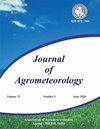Analyzing the efficiency of Arduino UNO microcontroller in monitoring and controlling the microclimatic parameters of greenhouse
Q3 Agricultural and Biological Sciences
引用次数: 0
Abstract
At present greenhouse farming has become more popular in contrast to traditional farming because of its adjustment capability of the environmental parameters such as temperature, humidity, light intensity, and soil moisture according to the requirements of the crops. Continuous monitoring and controlling facilities of the greenhouse system allow the farmers a good maintenance system with good quality and high yield of the crops. In this paper, an Arduino microcontroller was used in a greenhouse system for an automatic monitoring system for cultivation incorporating various sensors such as a temperature-humidity sensor, and soil moisture sensor to collect parameters for monitoring the environment of the greenhouse. The collected data were used to control the temperature using cooling fans which facilitated the greenhouse controlling the environment. For storage and processing the data the controller code was generated in the Arduino programming language, and finally inserted into the Arduino UNO R3 microcontroller. A solar power system with a rechargeable battery was installed as a source of energy to ensure continuous power supply to the greenhouse system. Implementation of a greenhouse with a microclimatic parameter monitoring and controlling system will result in mitigating land and labor requirement problems for small-scale farmers, and gardeners as well as supplying suitable data for agricultural researchers.分析 Arduino UNO 微控制器监测和控制温室微气候参数的效率
与传统农业相比,温室种植因其能够根据作物的需求调节温度、湿度、光照强度和土壤湿度等环境参数而变得更加流行。温室系统的连续监测和控制设施使农民能够很好地维护系统,保证作物的优质高产。本文在温室系统中使用了 Arduino 微控制器,该系统结合了各种传感器(如温湿度传感器和土壤水分传感器),用于采集温室环境监测参数,从而实现种植自动监控系统。收集到的数据用于利用冷却风扇控制温度,从而促进温室对环境的控制。为了存储和处理数据,用 Arduino 编程语言生成了控制器代码,最后将其插入 Arduino UNO R3 微控制器。为确保温室系统的持续供电,安装了带充电电池的太阳能发电系统作为能源来源。实施带有微气候参数监测和控制系统的温室,将减轻小规模农户和园艺师的土地和劳动力需求问题,并为农业研究人员提供合适的数据。
本文章由计算机程序翻译,如有差异,请以英文原文为准。
求助全文
约1分钟内获得全文
求助全文
来源期刊

Journal of Agrometeorology
农林科学-农艺学
CiteScore
1.40
自引率
0.00%
发文量
95
审稿时长
>12 weeks
期刊介绍:
The Journal of Agrometeorology (ISSN 0972-1665) , is a quarterly publication of Association of Agrometeorologists appearing in March, June, September and December. Since its beginning in 1999 till 2016, it was a half yearly publication appearing in June and December. In addition to regular issues, Association also brings out the special issues of the journal covering selected papers presented in seminar symposia organized by the Association.
 求助内容:
求助内容: 应助结果提醒方式:
应助结果提醒方式:


